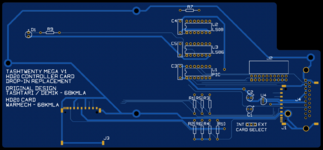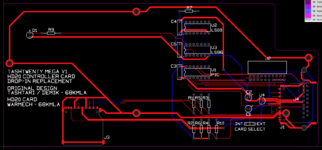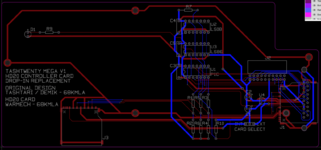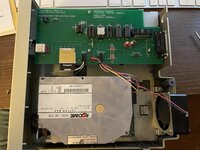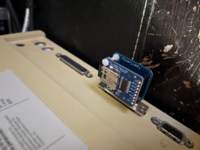warmech
Well-known member
Oh man, I forgot you could put custom icons on there!
Sorry, meant to respond yesterday and then the day went to hell at work. Noted on the enable lines - I'll get these fixed and post a shot of the EDA drawing for you to verify. As for the DB19s, I was initially thinking that folks would be able to desolder the DB19 connectors off of their old controller cards and slap 'em on this if they felt like it; that's a lot of work for solder wick, so that might really only be a feasible option for folks with Hakkos and the like. Your suggestion, however, is genius. I know exactly how I want to make an optional SD card slot in that opening work... I'll have something later today to show you.
Cool! I'm excited about having a new TashTwenty design out there, and I love the name.
To answer your question, pin 2 on the PIC is !ENBL2 in and pin 13 is !ENBL2 out. Daisy chaining DCDs is accomplished by the Mac pulsing PH3 - !ENBL2 out starts high, and the currently selected device disables itself when it sees the pulse on PH3 and asserts !ENBL2 low for the next device. This way, the Mac can select the first device by asserting !ENBL2 low, the second by asserting !ENBL2 low and pulsing PH3 once, the third by asserting !ENBL2 low and pulsing PH3 twice, &c.
Thusly, to make the daisy chain port work, you need to pass through all the lines from the main connector, except !ENBL2 (pin 17 on the 19-pin D-subminiature), which should be connected to pin 13 on the PIC.
Speaking of the daisy chain port, since PC-mount 19-pin female D-subs are nearly unobtainium, what about making it an option to stuff a full-size SD card slot that's accessible through the back window of the HD20 where the port is? Can the footprints fit over one another on the same board, or would it be necessary to make two separate board designs? Maybe a little riser board would make it work?
Sorry, meant to respond yesterday and then the day went to hell at work. Noted on the enable lines - I'll get these fixed and post a shot of the EDA drawing for you to verify. As for the DB19s, I was initially thinking that folks would be able to desolder the DB19 connectors off of their old controller cards and slap 'em on this if they felt like it; that's a lot of work for solder wick, so that might really only be a feasible option for folks with Hakkos and the like. Your suggestion, however, is genius. I know exactly how I want to make an optional SD card slot in that opening work... I'll have something later today to show you.

